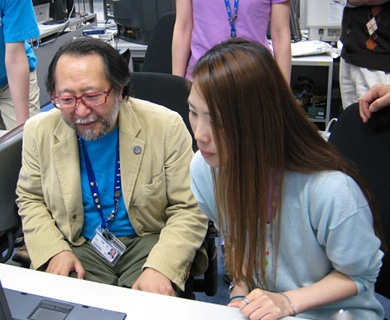This is an archive of information released in the past.
Disclaimer: It may contain broken links or outdated information. Some parts may not function in current web browsers.
*Visit https://humans-in-space.jaxa.jp/en/ for the latest information.

Experiment
- News
- Kibo Utilization Strategy
- Kibo Utilization Plan
- List of JAXA's Utilization Themes
- Experiment Facilities
- Space Environment Utilization
- Archive
Neuro Rad Experiment Completed
* All times are Japan Standard Time (JST)
Biological Effects of Space Radiation and Microgravity on Mammalian Cells (Neuro Rad)*, which has been conducted using the Cell Biology Experiment Facility (CBEF) in Kibo, was successfully completed.
*Principal Investigator (PI): Hideyuki Majima, Professor of Kagoshima University
Samples for the experiment were launched aboard the space shuttle Discovery on the STS-131 mission on April 5, 2010. The Neuro Rad experiment began at 8:45 p.m. on April 8, 2010, with commands sent from the Tsukuba Space Center (TKSC).
During the Neuro Rad experiment, nerve cell samples were cultured at 37 degrees Celsius in both the microgravity compartment and the artificial 1G gravity compartment of the CBEF. The nerve cell samples were collected on Day 15 and Day 29 from the both groups, and were chemically fixed and frozen until return to the ground.
The Neuro Rad experiment investigates effect of space radiation on human nerve cells through two different approaches.
One approach tries to determine what types of genes are affected by space radiation. The other tries to identify the gene that plays a key role in apoptosis (programmed cell death) induced by mitochondria in a cell.
After the samples are returned to the ground, the Neuro Rad team will perform analysis of the samples to examine gene expressions and gene activities. The team will focus on genes involved in mitochondrial activity and protein activity that produce energy in a cell.
Space radiation will not only affect genes but also induce active oxygen production in a cell. The produced active oxygen in a cell is assumed to be an inducing factor of the cell malfunctioning and aging. The team will also investigate the substances affected by active oxygen and the active oxygen scavenging enzymes to determine indirect effects of space radiation on cells.
On the ground, the team will analyze mitochondria-related gene/protein activities and apoptosis-induced gene/protein activities. Through the analysis, specific information on effect of long-term space radiation exposure on nerve cells will be clarified.
The samples are scheduled to be returned to the ground aboard the space shuttle Atlantis on the STS-132 Mission.
Special Message from Principal Investigator (PI)
For the past 28 days, our experiment was performed just as planned. Environment was maintained at 1G and 37 degree Celsius throughout the experiment. It was the first attempt to conduct this kind of experiment. The in-flight protocol was successfully completed thanks to the supports from JAXA, Space Forum and JAMSS.
We will examine effects of space radiation on mammalian cells and molecular biological factors, hoping that our experiment in space would yeild a great result.

Professor Majima (left) and Instructor Hiroko Inukai (right)
monitoring the experiment from the User Operations Area (UOA) at TKSC
*All times are Japan Standard Time (JST)
| Copyright 2007 Japan Aerospace Exploration Agency | Site Policy |